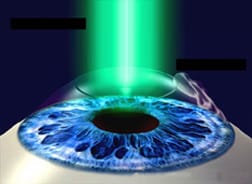Photo-Refractive Keratectomy (PRK)
In PRK (Photo-Refractive Keratectomy), the cells covering the outer corneal surface (the epithelium) are removed, and the laser sculpts the front layers of collagen. The cells heal over the treated area in about 4 days. A soft contact lens is placed to afford comfort during this interval. After surface treatment, visual recovery to optimum levels usually takes several days to a few weeks. Eye drops are necessary to help guide the healing process, and these usually need to be continued for several weeks to a few months after treatment.
 There are various terms for surface treatment that have been employed since the inception of laser vision correction. The first procedure to be performed was PRK. A newer term for this procedure is ASA (for “Advanced Surface Ablation”)
There are various terms for surface treatment that have been employed since the inception of laser vision correction. The first procedure to be performed was PRK. A newer term for this procedure is ASA (for “Advanced Surface Ablation”)
LASEK (with an “E”, for Laser Assisted Sub-Epithelial Keratomileusis) is a procedure very similar to PRK. The surface lining cells are removed but retained, and after laser sculpting are replaced. The healing is virtually identical to PRK, since the lining cells can be injured by the removal process, and are replaced by new cells as in PRK. Another term for LASEK is “epiLASIK”.
To further confuse the consumer, some centers that strictly perform surface treatment market their services as a form of “flapless LASIK“. This is simply misleading. All of these techniques use the excimer laser to perform the optical sculpting in exactly the same fashion.
PRK may be recommended in situations where corneal thickness is not adequate to retain mechanical stability after taking into account the anticipated flap thickness and calculated depth of laser sculpting treatment. Experienced physicians do differ in their opinion on these issues. At LA Sight, all relevant factors are measured, and taken into consideration as a part of determining your candidacy for vision correction. To learn more about the testing we perform at the initial evaluation, see our pages on Vision Consultation and Why PRK in Some Cases.
PRK should not be undertaken lightly; this is not trivial surgery even though it is rather quick, and painless. We recommend careful selection of a provider and offer advice through our 50 Tough Questions to Ask Your Surgeon and Finding a Good Laser Surgeon pages.